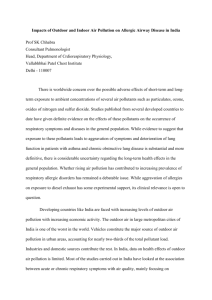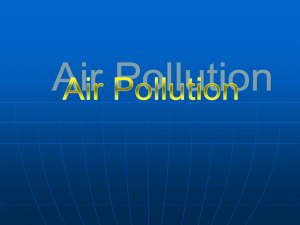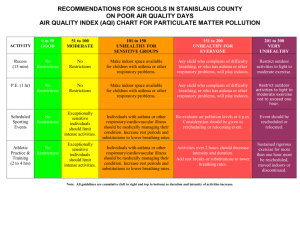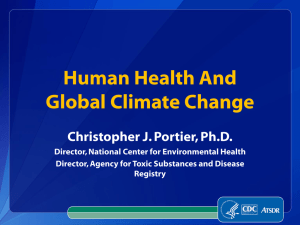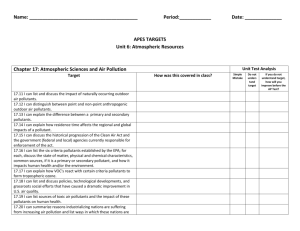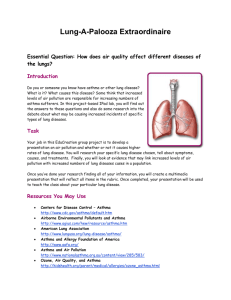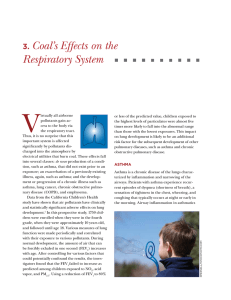ASTHMA AND POLLUTION - Info
advertisement
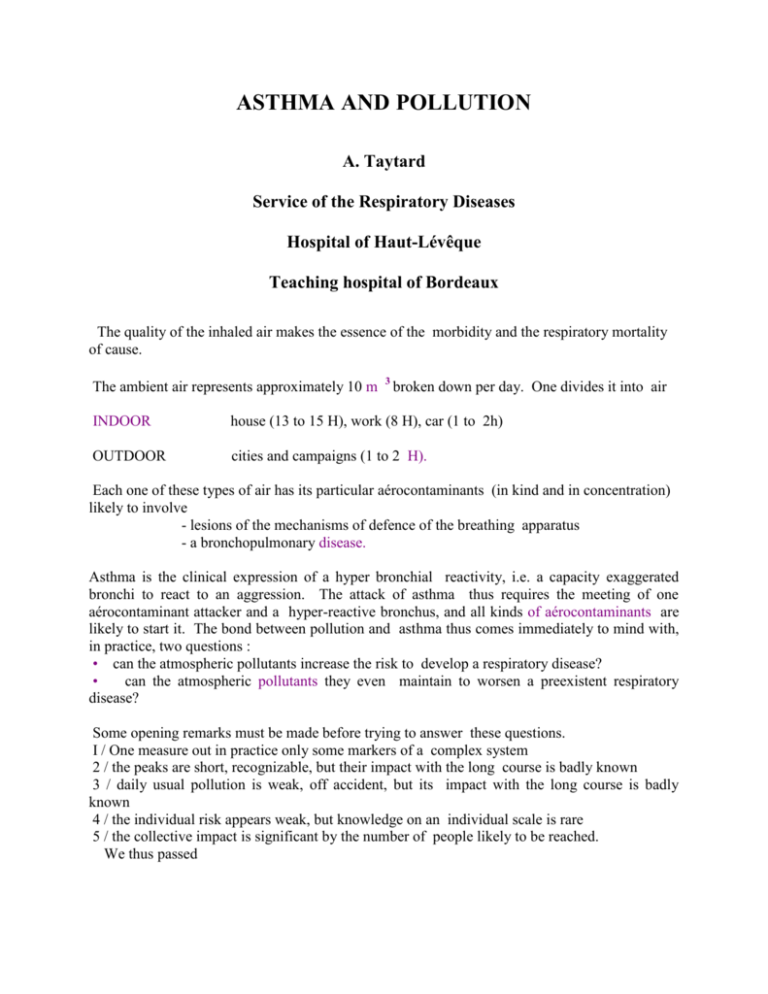
ASTHMA AND POLLUTION A. Taytard Service of the Respiratory Diseases Hospital of Haut-Lévêque Teaching hospital of Bordeaux The quality of the inhaled air makes the essence of the morbidity and the respiratory mortality of cause. The ambient air represents approximately 10 m 3 broken down per day. One divides it into air INDOOR house (13 to 15 H), work (8 H), car (1 to 2h) OUTDOOR cities and campaigns (1 to 2 H). Each one of these types of air has its particular aérocontaminants (in kind and in concentration) likely to involve - lesions of the mechanisms of defence of the breathing apparatus - a bronchopulmonary disease. Asthma is the clinical expression of a hyper bronchial reactivity, i.e. a capacity exaggerated bronchi to react to an aggression. The attack of asthma thus requires the meeting of one aérocontaminant attacker and a hyper-reactive bronchus, and all kinds of aérocontaminants are likely to start it. The bond between pollution and asthma thus comes immediately to mind with, in practice, two questions : • can the atmospheric pollutants increase the risk to develop a respiratory disease? • can the atmospheric pollutants they even maintain to worsen a preexistent respiratory disease? Some opening remarks must be made before trying to answer these questions. I / One measure out in practice only some markers of a complex system 2 / the peaks are short, recognizable, but their impact with the long course is badly known 3 / daily usual pollution is weak, off accident, but its impact with the long course is badly known 4 / the individual risk appears weak, but knowledge on an individual scale is rare 5 / the collective impact is significant by the number of people likely to be reached. We thus passed • from significant exposures (professional, accidental) producing diseases clinically and almost immediately observable, to weak exposures whose consequences visible are only projected on a population scale, • from a search for individual prevention to the search of a reduction of risk for the whole of a population. The evaluation of the risk is done in 4 stages 1. Identification of the pollutant to be accused: One establishes a first preliminary bond from cause to effect, between the exposure to a product and certain noxious effects on health; one uses for that the epidemiologic investigations, animal toxicity and the data of in vitro toxicity; 2. Evaluation of the relation "amount-answer": It is the description of the quantitative relation which exists between the exposure to a product and the type, the incidence or the severity of the result observed, one uses for that the animal experimentation, human data derived from accidental exposures , professional, or controlled in experimental condition; 3. Evaluation of the exposure: It is the identification and the characterization of the exposed populations, and the determination of the amplitude and the exposure time; it depends on the demographic data and the monitoring of errvironment 4. Characterization of the risk: One integrates here the results of the 3 preceding stages to produce an estimate of the possibility that a harmful effect on health occurs, and the frequency and the severity with which the result can be awaited in the population under certain conditions. The markers of the effect of the air pollution on the breathing apparatus are numerous 1 / cardiorespiratory excess of mortality 2 / Rise of the consumption of care (visits, urgencies, hospitalizations) 3 / Exacerbations of asthma (visits, drugs, DP) 4 / Increase in the other respiratory diseases 51 Augmentation in the respiratory symptoms 6 / Fall of the respiratory function (spirometry, DP, resistances) 7 / Increase in the bronchial reactivity 8 / Bronchopulmonary inflammation (cells, mediators) 9 / Deterioration of pulmonary morphology 10/Alteration of the systems of defense (clearance muco-ciliaire, macrophagic function, immunizing answer) 11/Cellular injuries The impact of pollution on asthma is done under 2 conditions * into acute and chronicle * at the laboratory and in the population 1/ AT THE LABORATORY Advantages : The subjects, homogeneous, are well defined and the experimenter controls the exposure, the symptoms, the physiological and biological variables. Limits : The external validation of these results poses problem insofar as one uses single pollutants or simple mixtures during acute or subacute tests, which do not answer the chronicity of a complex environment. In addition their cost limit their use. Interests : One can characterize the effects of a specific pollutant and make assumptions on the mechanisms of action. 2/ IN EPIDEMIOLOGY Advantages : The epidemiology makes it possible to study the relation exposition/effects on health in the general population and the populations with risk. They are there real subjects put throught a real exposure. Limits : These studies do not make it possible to really control neither the exposure to the pollutant nor the Co-factors; however there is myriade of inhaled pollutants each day and in each type of environment. In addition one practically does not have individual data. Lastly, the risk of skew is major. Taking into account all these remarks, one can retain the following results: there is not formal proof, today, that the atmospheric pollutants increase there prévalence of asthma. They can, on the other hand, increase mortality and morbidity by it in usual living conditions. 1 / in the short run An exposure to ozone causes a fall of the VEMS and an increase in the bronchial reactivity but there are 10 to 20% of nonresponders and a phenomenon of tolerance appears at the end of 3 to 5 days. 2 / in the medium term The recourse for asthma to the emergency services is significantly associated - with the PM10 the previous day for the subjects of less than 65 years, - on the level of exposure to ozone and S0 2 for the children. * There is a relation between the increase in the concentrations of ozone and S0 atmosphere and - reduction in the ventilatory function measured by the peak output, - appearance of respiratory symptoms, the catch of bronchi dilatings , and for levels of pollution lower than nuns WHO 2 in the At the asthmatic severe ones, the PM 2,5 increase the scores of asthma. In the asthmatic children, there is a significant relation between the level of particles PM 10 • and - reduction in the peak output, - increase in the prévalence of the respiratory syrnptômes, - medicamentous consumption. One can conclude from it that • the harmful effect of certain components of pollution is now established, including for relatively low levels of pollution and without real effects of threshold • the atmospheric pollutants are likely to have an additive harmful effect, even synergic To improve the situation one can wish • an improvement of the quality of the air, but the definition of the thresholds is not field of the scientific expertise, • an alarm, prediction, and monitoring system, • councils adapted to the populations with risk, but which do not marginalize them, • an effort of research taking in account individual measurements. • And without forgetting the interior pollution which is that in which one bathes during 90% of our life . _______________
